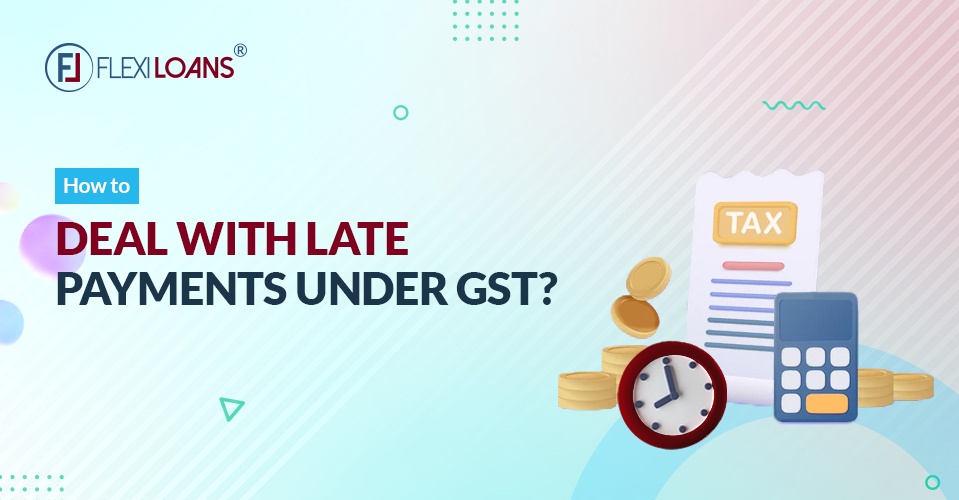How to Deal With Late Payments Under GST?
Nov 22, 2022

Introduction
The Goods and Services Tax (GST) is an indirect value-added tax applied on most products and services supplied for domestic consumption. A late charge is an amount assessed under the GST Act for late entry of GST returns. GST requires the filing of returns. Even if there is no GST return sum to be paid – you must submit a NIL GST return within the stipulated time limit.
When a GST-registered firm fails to submit GST returns by the stipulated deadlines, a prescribed late charge is levied for each day of delay. You will be charged a per-day late fee if you fail to file your GST/NIL returns by the deadline.
You need to pay the GST late charge in cash, and in doing so, you cannot use the Input Tax Credit (ITC) —provided in the electronic credit ledger— to pay it. The late fine also applies to the non-filing of NIL GST returns.
| Form | Use |
| PMT-01 GST | In this form, an electronic tax bill record is kept. |
| PMT-02 GST | An electronic credit ledger is kept in this form. |
| PMT-02 GST | Order by relevant officials to re-credit money upon refund refusal. |
| PMT-04 GST | Reporting discrepancies in the computerised credit ledger, money ledger, or liability ledger. |
| PMT-05 GST | In this form, an electronic cash ledger is kept. |
| PMT-06 GST | Challan for GST payment. |
| PMT-07 GST | This application is used when CIN (Challan Identification Number) isn’t created or sent to the common site. |
Four ways to deal with GST payment delays
1. Control payment defects
Keeping payment delays under control is the best way to sustain a stable cash flow. You may control cash flow by keeping a record of invoice payments and past-due payments. An e-invoicing system may help you manage your e-invoicing process and keep a record of bills regularly. The second method is to determine how your customers pay so that you may inform them if their payment date has gone. This brings us to the next stage, which is follow-up.
2. Follow up
When following up, bear in mind that payments might be delayed for a variety of reasons. Waiting for payments, going via accounting processes, and dealing with regulatory problems are all common issues. When checking back on a past-due pay, you must do it respectfully and properly. You might also offer the following option:
- Increase the payment period
- Payments in installments
- Early payment discounts
- Late payment penalty
Remember that the most vital component of follow-up is providing answers to customers. You must contact your client’s accounts payable department since they can handle the payment due. You may, however, automate this procedure by utilising an e-invoicing tool.
3. Please be patient
You’ll have to wait a while after following it up with the client’s AP section since the payment processing due takes time. Payments may be made using different methods, including:
- Payment with UPI or cards
- Cheque/DD/PDC
- You need to be patient and understand that your customers have their businesses to run.
4. Make a credit note
If a company does not pay within the agreed-upon time, you may issue a credit note for the amount owed, and the receiver must reverse the credit.
Penalty for wrong use of GST credit
The sum of interest imposed on GST delayed payment is shown in the table below. In addition, in the event of tax evasion, a fine at the following rate may be imposed:
| Payment time | Fine amount |
| Before posting the show cause letter | 15% of the total tax owed |
| Within 30 days of getting the notice of show cause | 25% of the total tax owed |
| Within 30 days of receiving the order | 50% of the total tax payable |
| In any other context | 100% of the tax sum |
Amount of late fees applicable under GST
The 43rd GST Council meeting, held in June 2021, simplified GST payment late fines and penalties.
- The maximum late charge for non-filing GSTR-1 and GSTR-3B returns is Rs 500 per return– Rs 250 each for CGST and SGST.
- If your business’s total annual revenue was up to Rs 1.5 crore in the previous financial year, you have to pay a late charge of up to Rs 2,000 per return – Rs 1,000 each for CGST and SGST.
- If your previous year’s turnover was between Rs 1.5 crore and Rs 5 crore, you have to pay a maximum late charge of Rs 5,000 per return – Rs 2,500 each for CGST and SGST.
- However, if your turnover was above Rs 5 crores in the last financial year, you may have to pay a late charge of up to Rs 10,000 – i.e., Rs 5,000 each for CGST and SGST.
- Apart from these, the CGST notice 21/2021, dated 1st June 2021, has rationalised the late filing cost of GSTR-4 from FY 2021-22. The maximum late charge for NIL filing will be Rs 500 and Rs 2,000 for non-zero filing.
- The CGST notice 22/2021, dated 1st June 2021, has revised the late penalty charged for the GSTR-7, i.e., the TDS filing under GST, to Rs 2,000, although the late cost per day imposed is reduced from Rs 200 to Rs 50 per act, per return.
Conclusion
Annual GST returns are subject to Rs 100 per day late fees under CGST legislation and Rs 100 per day under SGST law. Consequently, a daily fine of Rs 200 is levied until the late fees are paid. The maximum penalty for a fiscal year cannot exceed 0.25% of the taxpayer’s entire turnover.
The government levies interest and late fines to ensure prompt and timely payment and filing of taxes. The GST Portal automatically accounts for any delays in GSTR-3B, and no return is issued until payment is made. Any waivers are refunded to the cash ledger and may be utilised again later by the taxpayer.
Late fees are calculated automatically and reported in the next month’s GSTR-3B. In contrast, interest must be calculated manually and entered into GSTR-3B for payment. You must pay late fines and interest individually for CGST, SGST, and IGST. GST fines cannot be paid using Input Tax Credits. A challan is necessary for both online and offline GST payments.
Read More
The Impact Of GST On Business Loans?
List Of Documents Needed For Gst Registration









